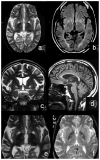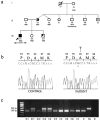Neuroferritinopathy: missense mutation in FTL causing early-onset bilateral pallidal involvement
- PMID: 16116125
- PMCID: PMC2886026
- DOI: 10.1212/01.wnl.0000178224.81169.c2
Neuroferritinopathy: missense mutation in FTL causing early-onset bilateral pallidal involvement
Abstract
The authors identified a missense mutation in the FTL gene (474G>A; A96T) in a 19-year-old man with parkinsonism, ataxia, corticospinal signs, mild nonprogressive cognitive deficit, and episodic psychosis. This mutation was also present in his asymptomatic mother and younger brother, who had abnormally low levels of ferritin in the serum. The patient and his mother displayed bilateral involvement of the pallidum.
Conflict of interest statement
Disclosure: The authors report no conflicts of interest.
Figures


Similar articles
-
Mutation in the gene encoding ferritin light polypeptide causes dominant adult-onset basal ganglia disease.Nat Genet. 2001 Aug;28(4):350-4. doi: 10.1038/ng571. Nat Genet. 2001. PMID: 11438811
-
Extrapyramidal and cerebellar movement disorder in association with heterozygous ceruloplasmin gene mutation.J Neurol. 2005 Jan;252(1):111-3. doi: 10.1007/s00415-005-0608-3. J Neurol. 2005. PMID: 15654567 No abstract available.
-
Voxel-based analysis in neuroferritinopathy expands the phenotype and determines radiological correlates of disease severity.J Neurol. 2015 Oct;262(10):2232-40. doi: 10.1007/s00415-015-7832-2. Epub 2015 Jul 4. J Neurol. 2015. PMID: 26142024 Free PMC article.
-
[Clinical features of neuroferritinopathy].Rinsho Shinkeigaku. 2009 May;49(5):254-61. doi: 10.5692/clinicalneurol.49.254. Rinsho Shinkeigaku. 2009. PMID: 19594102 Review. Japanese.
-
Magnetic resonance imaging in CBD, related atypical parkinsonian disorders, and dementias.Adv Neurol. 2000;82:197-208. Adv Neurol. 2000. PMID: 10624483 Review. No abstract available.
Cited by
-
Mutant ferritin L-chains that cause neurodegeneration act in a dominant-negative manner to reduce ferritin iron incorporation.J Biol Chem. 2010 Apr 16;285(16):11948-57. doi: 10.1074/jbc.M109.096404. Epub 2010 Feb 16. J Biol Chem. 2010. PMID: 20159981 Free PMC article.
-
Serum ferritin level changes in children with sickle cell disease on chronic blood transfusion are nonlinear and are associated with iron load and liver injury.Blood. 2009 Nov 19;114(21):4632-8. doi: 10.1182/blood-2009-02-203323. Epub 2009 Aug 31. Blood. 2009. PMID: 19721013 Free PMC article. Clinical Trial.
-
Mutant L-chain ferritins that cause neuroferritinopathy alter ferritin functionality and iron permeability.Metallomics. 2019 Oct 16;11(10):1635-1647. doi: 10.1039/c9mt00154a. Metallomics. 2019. PMID: 31513212 Free PMC article.
-
Brain iron homeostasis: from molecular mechanisms to clinical significance and therapeutic opportunities.Antioxid Redox Signal. 2014 Mar 10;20(8):1324-63. doi: 10.1089/ars.2012.4931. Epub 2013 Aug 15. Antioxid Redox Signal. 2014. PMID: 23815406 Free PMC article. Review.
-
The neuropsychiatry of hyperkinetic movement disorders: insights from neuroimaging into the neural circuit bases of dysfunction.Tremor Other Hyperkinet Mov (N Y). 2013 Aug 26;3:tre-03-175-4242-1. doi: 10.7916/D8SN07PK. eCollection 2013. Tremor Other Hyperkinet Mov (N Y). 2013. PMID: 24032090 Free PMC article.
References
-
- Curtis A, Fey C, Morris C, et al. Mutation in the gene encoding ferritin light polypeptide causes dominant adult-onset basal ganglia disease. Nat Genet. 2001;28:350–354. - PubMed
-
- Wills A. Hereditary neuroferritinopathy presenting with palatal tremor, orofacial dyskinesias, bulbar symptoms, and unsteadiness of gait. Mov Disord. 2003;18:1057.
-
- Vidal R, Ghetti B, Takao M, et al. Intracellular ferritin acumulation in neural and extraneural tissue characterizes a neurodegenerative disease associated with a mutation in the Ferritin Light Polypeptide gene. J Neuropathol Exp Neurol. 2004;63:363–380. - PubMed
Publication types
MeSH terms
Substances
Grants and funding
LinkOut - more resources
Full Text Sources
Medical
Molecular Biology Databases
Miscellaneous
